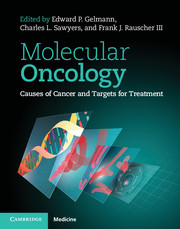Book contents
- Frontmatter
- Dedication
- Contents
- List of Contributors
- Preface
- Part 1.1 Analytical techniques: analysis of DNA
- Part 1.2 Analytical techniques: analysis of RNA
- Part 2.1 Molecular pathways underlying carcinogenesis: signal transduction
- Part 2.2 Molecular pathways underlying carcinogenesis: apoptosis
- Part 2.3 Molecular pathways underlying carcinogenesis: nuclear receptors
- Part 2.4 Molecular pathways underlying carcinogenesis: DNA repair
- Part 2.5 Molecular pathways underlying carcinogenesis: cell cycle
- Part 2.6 Molecular pathways underlying carcinogenesis: other pathways
- Part 3.1 Molecular pathology: carcinomas
- Part 3.2 Molecular pathology: cancers of the nervous system
- Part 3.3 Molecular pathology: cancers of the skin
- Part 3.4 Molecular pathology: endocrine cancers
- Part 3.5 Molecular pathology: adult sarcomas
- Part 3.6 Molecular pathology: lymphoma and leukemia
- Part 3.7 Molecular pathology: pediatric solid tumors
- Part 4 Pharmacologic targeting of oncogenic pathways
- 78 Oncology drug discovery for biologics: antibody development strategies and considerations
- 79 Targeting the EGFR family of receptor tyrosine kinases
- 80 Therapeutic approaches with antibodies to cell-surface receptors
- 81 Signal transduction in tumor angiogenesis
- 82 Tyrosine-kinase inhibitors in oncology
- 83 Anti-estrogens and selective estrogen-receptor modulators
- 84 Therapeutic applications of anti-sense mechanisms for the treatment of cancer
- 85 Induction of apoptosis
- 86 DNA-methylation inhibitors
- 87 Histone deacetylase inhibitors
- 88 Drug resistance: as complex and diverse as the disease itself
- 89 Molecular profiling and therapeutic decision-making: the promise of personalized medicine
- 90 DNA repair inhibition in anti-cancer therapeutics
- Index
- References
81 - Signal transduction in tumor angiogenesis
from Part 4 - Pharmacologic targeting of oncogenic pathways
Published online by Cambridge University Press: 05 February 2015
- Frontmatter
- Dedication
- Contents
- List of Contributors
- Preface
- Part 1.1 Analytical techniques: analysis of DNA
- Part 1.2 Analytical techniques: analysis of RNA
- Part 2.1 Molecular pathways underlying carcinogenesis: signal transduction
- Part 2.2 Molecular pathways underlying carcinogenesis: apoptosis
- Part 2.3 Molecular pathways underlying carcinogenesis: nuclear receptors
- Part 2.4 Molecular pathways underlying carcinogenesis: DNA repair
- Part 2.5 Molecular pathways underlying carcinogenesis: cell cycle
- Part 2.6 Molecular pathways underlying carcinogenesis: other pathways
- Part 3.1 Molecular pathology: carcinomas
- Part 3.2 Molecular pathology: cancers of the nervous system
- Part 3.3 Molecular pathology: cancers of the skin
- Part 3.4 Molecular pathology: endocrine cancers
- Part 3.5 Molecular pathology: adult sarcomas
- Part 3.6 Molecular pathology: lymphoma and leukemia
- Part 3.7 Molecular pathology: pediatric solid tumors
- Part 4 Pharmacologic targeting of oncogenic pathways
- 78 Oncology drug discovery for biologics: antibody development strategies and considerations
- 79 Targeting the EGFR family of receptor tyrosine kinases
- 80 Therapeutic approaches with antibodies to cell-surface receptors
- 81 Signal transduction in tumor angiogenesis
- 82 Tyrosine-kinase inhibitors in oncology
- 83 Anti-estrogens and selective estrogen-receptor modulators
- 84 Therapeutic applications of anti-sense mechanisms for the treatment of cancer
- 85 Induction of apoptosis
- 86 DNA-methylation inhibitors
- 87 Histone deacetylase inhibitors
- 88 Drug resistance: as complex and diverse as the disease itself
- 89 Molecular profiling and therapeutic decision-making: the promise of personalized medicine
- 90 DNA repair inhibition in anti-cancer therapeutics
- Index
- References
Summary
Angiogenesis is the formation of nascent blood vessels from existing vasculature. It is a crucial step in physiological conditions such as normal growth, embryonic development, female estrous cycle, and wound healing, as well as in pathological scenarios such as tumor growth, diabetic retinopathy, and rheumatoid arthritis (1). During cancer progression, the angiogenic vasculature is needed for the supply of oxygen and nutrients that sustain tumor growth, and eventually acts as a conduit for metastatic dissemination of tumor cells to distant organs (2,3). Accordingly, tumor angiogenesis remains an important area of cancer research, and understanding its mechanistic basis is critical for the development of effective anti-angiogenic therapy.
Under normal physiological conditions, angiogenesis is well controlled by pro- and anti-angiogenic factors. However, in cancer, this balance of pro- and anti-angiogenic factors is perturbed, resulting in the so-called “angiogenic switch.” Multiple signals trigger the angiogenic switch, including genetic mutations, metabolic and mechanical stresses, and inflammatory responses (4–9; Figure 81.1). Growing tumors progressively become hypoxic, leading to stabilization of the hypoxia inducible factor 1α (HIF-1α) which, in turn, stimulates production of key angiogenic growth factors, including vascular endothelial growth factor (VEGF), platelet-derived growth factor (PDGF), placental growth factor (PLGF), granulocyte colony-stimulating factor (G-CSF), interleukin 8 (IL8), and hepatocyte growth factor (HGF). VEGF-A has been heralded as the most potent endothelial-specific angiogenic factor, which recognizes cognate tyrosine-kinase receptors such as VEGFR-2 and -3 on the endothelial cells, resulting in downstream activation of signal-transduction cascades (10), which induce endothelial cell activation and sprouting of new capillaries. In addition to the pro-angiogenic factors, there are various endogenous angiogenesis-inhibitor proteins including endostatin, angiostatin, thrombospondin-1 (Tsp-1), tumstatin, platelet factor 4, and certain interleukins, including IL-12. De novo blood-vessel formation results from a complex interplay of pro- and anti-angiogenic regulators, and dysregulation of the balance between these factors is the hallmark of tumor angiogenesis. In addition to the participation of vascular endothelial-derived vessels, the generation of new lymphatic vessels by a process referred to as lymphangiogenesis has also been implicated in tumor progression and metastasis (11,12).
- Type
- Chapter
- Information
- Molecular OncologyCauses of Cancer and Targets for Treatment, pp. 861 - 871Publisher: Cambridge University PressPrint publication year: 2013

